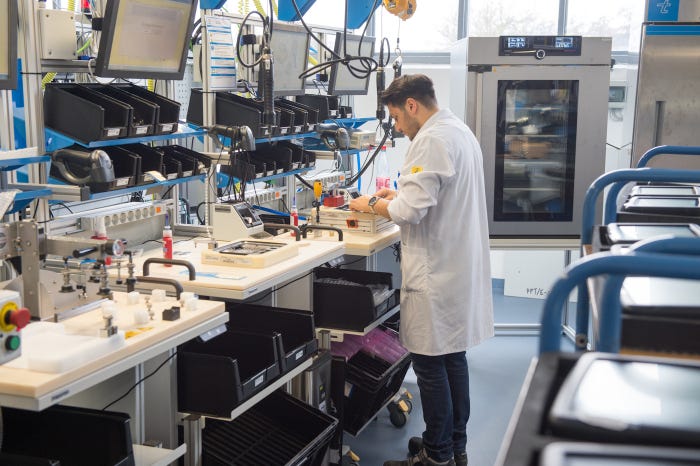March 31, 2016

<p>Building monitors is no easy task, and for Wachendorff, part of the Topcon family, testing is critical.</p>
NOTE: The photos above walk you through the process of designing and testing monitors that can stand up to agriculture. Read on to learn more about Wachendoff and its history - including the firm's first epic fail in agriculture.
The road to success is often a bumpy one. And for Wachendoff, becoming one of the leaders in the design and manufacturing of display consoles for the agriculture and off-highway market, those bumps are what helped fuel the development of this world-class firm.
Wachendorff started in 1978 as a trading company that designed display consoles for manufacturing. Business was good, and the relatively small staff gained a steady client base from their headquarters in Geisenheim, Germany.
But in the mid-1990s, the company took on a project that would propel it to the success it enjoys today. The tractor manufacturer Fendt wanted an electronic console for its tractors, and Wachendorff delivered the prototype to Fendt engineers.
The first test didn’t go as planned. As Thilo Nagel, general manager at Wachendorff, explains, “Fendt engineers took the first design of the console and subjected it to a battery of tests that simulated real-world working conditions. After some time the pieces of the console were returned. It was back to the drawing board.”
Determined to succeed
But that first test did not deter Wachendorff. Instead, it was taken as a new challenge to design the console to withstand extreme conditions and develop testing procedures that, to this day, are ingrained into the Wachendorff culture. In 1998, Wachendorff delivered its revolutionary console that was a precursor of the units of today.
Wachendorff may not be a name you’ve heard of before, but it is a leading manufacturer of in-cabin mounted consoles for the agricultural and construction industries. Peter and Robert Wachendorff recently sold the company to Topcon. “This acquisition is a key ingredient of our global strategy to strengthen our ability to serve original equipment manufacturers and establish the foundation for Topcon manufacturing in Europe,” Ray O’Connor, Topcon Positioning Group president and CEO said at the announcement of the purchase. “This world-class facility in Germany is second-to-none in its operational quality, employee dedication, and astute leadership — all of the characteristics needed to exceed the high-precision standards required for our industry.”
Torture test, from start to finish
The Wachendorff company of today is a far cry from its humble beginnings. The seven employees who crowded into the headquarters –located in Rolf Wachendorff’s family home – is now a global market leader with more than 100 employees in a large building in Geisenheim.
In addition to the assembly of control units for Topcon, as well as other Wachendorff clients, new concepts, new product designs and new components are also put through their paces. Approximately half of the employees are engineers who are working on the design and manufacture of new control unit concepts, as well as improving current designs.
And what Rolf and his employees learned from that first test with Fendt has become a hallmark of Wachendorff: It’s product testing – to the extreme.
A large room within the Wachendorff facilities is filled with testing equipment. It is where a tractor console (or a new concept for a tractor console) is subjected to every imaginable test. Cold, heat, water, salt, vibration, electromagnetic shocks, exposure to chemicals...it’s a veritable torture chamber. Pre-production parts are subjected to various tests all along the development phase and final prototypes have to withstand hundreds of hours of tests before they go into production. “Our tests replicate what happens in the real world,” Nagel says. “And more. We want to ensure that every unit we produce is of the highest quality and is of the most durable design. It is what our customers demand, and what we demand of ourselves.”
Units are hand assembled in Geisenheim in specific work bays by dedicated teams. And while only two or three employees may constitute the assembly line for a given controller, it is a streamlined process that is backed up by a team of employees who work on the entire supply chain. Even at assembly, every unit finally goes through an initial test. It is “cooked” in an oven at 60 °C (140 °F), then cooled down to minus 30 °C (minus 22 °F), then heated up again. After that, there is a vibration test and the unit is switched on again for a final functional test before being packed in a box for shipping.
At Wachendorff more than 55,000 consoles are produced every year. Each and every console has to go through the same battery of tests before it goes out the door.
Challenges, and opportunities
While Wachendorff prides itself on the company’s ability to consistently produce durable and reliable consoles, production does come with its own unique challenges. The availability of the inner workings of the display units is of prime concern to the engineers. “When we design a unit, we must ensure every part going into the unit will be available for several years,” Nagel says. “That can be very difficult, especially with how fast computer parts change.”
So while the exterior of a control unit may look the same from year to year, the components inside may be different. However, engineers must ensure all units work the same. “We may upgrade a certain piece within a unit, but we must know that it will work the same way,” Nagel says.
The demands put upon controllers in farm machinery continue to grow and engineers have to create units that are easy to use, easy to understand and provide a positive experience to the end-user at the same time. “Even as controllers can do more things, they also have to be functional,” Nagel says. “This is an opportunity for us, since our employees understand that a console is more than a piece of electronics in the cab. It is a resource that an operator uses every time he gets into the cab. It must work, and work well.”
About the Author(s)
You May Also Like






